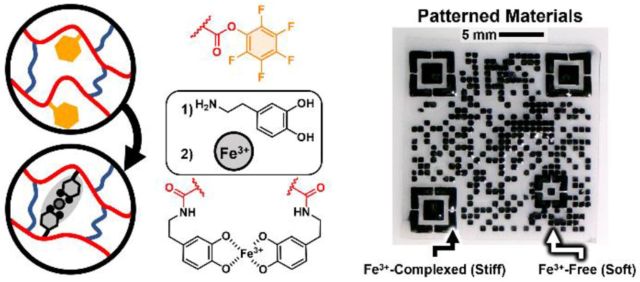
Modular Synthesis and Patterning of High-Stiffness Networks by Postpolymerization Functionalization with Iron–Catechol Complexes
Declan P. Shannon, Joshua D. Moon, Christopher W. Barney, Nairiti J. Sinha, Kai-Chieh Yang, Seamus D. Jones, Ronnie V. Garcia, Matthew E. Helgeson, Rachel A. Segalman, Megan T. Valentine, Craig J. Hawker. Macromolecules 56(6): 2268–2276 (2023).
Abstract
Bioinspired iron–catechol cross-links have shown remarkable success in increasing the mechanical properties of polymer networks, in part due to clustering of Fe3+–catechol domains which act as secondary network reinforcing sites. We report a versatile synthetic procedure to prepare modular PEG-acrylate networks with independently tunable covalent bis(acrylate) and supramolecular Fe3+–catechol cross-linking. Initial control of network structure is achieved through radical polymerization and cross-linking, followed by postpolymerization incorporation of catechol units via quantitative active ester chemistry and subsequent complexation with iron salts. By tuning the ratio of each building block, dual cross-linked networks reinforced by clustered iron–catechol domains are prepared and exhibit a wide range of properties (Young’s moduli up to ∼245 MPa), well beyond the values achieved through purely covalent cross-linking. This stepwise approach to mixed covalent and metal–ligand cross-linked networks also permits local patterning of PEG-based films through masking techniques forming distinct hard, soft, and gradient regions.